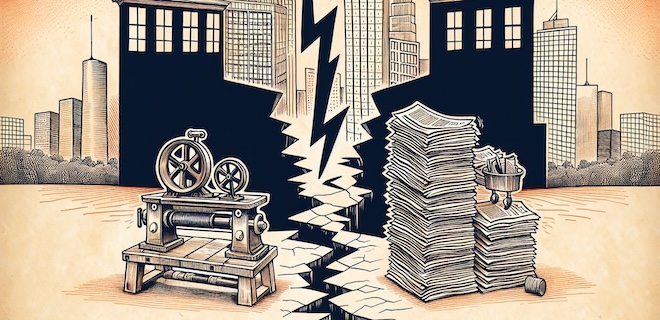 |
|||||||||
|
|||||||||
| Business Insider’s Layoffs Are a Tremor in a Bigger Media Quake |
 |
Business Insider, once the poster child for viral news and breakneck traffic growth, is now in the throes of a dramatic transformation. The company slashed 21% of its staff—at least 100 jobs—last Thursday, targeting not just junior reporters but a swath of senior editorial talent, including executive editors and award-winning journalists. The cuts span entertainment, environment, personal finance and technology, hobbling the teams that once fueled BI’s meteoric rise. The numbers tell a stark story: BI’s traffic has halved since 2020, plummeting from 160 million monthly visitors to just 80 million in early 2025, according to Similarweb. Successive Google algorithm changes and the rise of no-click generative AI search, along with Facebook’s retreat from news, have battered its audience. In response, Business Insider CEO Barbara Peng is steering the ship away from general news and ecommerce, while doubling down on business coverage and paid subscriptions. AI in the Newsroom Perhaps the most controversial element of BI’s new direction is its “all in on AI” mandate. Peng’s note to staff made it clear: The company expects every employee to use enterprise ChatGPT in their work, with a target of 100% adoption. Yet, as the National Union of Journalists (NUJ) and departing BI staffers warn in response to the layoffs, generative AI remains an imperfect tool for journalism—prone to errors and hallucinations and incapable of replacing the hard-won expertise and original reporting that define quality news. The NUJ’s verdict is blunt: “AI will never replace journalists, not unless the future media bosses want is one where content is regurgitated in perpetuity,” a union spokesperson said. “We all deserve better than that.” A Broader Industry Crisis If BI’s cuts feel seismic, they’re part of a much larger fault line running through the industry. In just the past two months: Disney laid off 200 staff members across its TV and film divisions, including at ABC News, as it pivots to streaming and high-margin originals. Los Angeles Times trimmed more than 20% of its newsroom positions in May, the third cut in as many years, citing subscriber losses and revenue declines. Vox Media sold its video game news brand Polygon to Canadian media company Valnet and cut most of its editorial staff, gutting a once-thriving publication. These moves highlight a grim reality: The ad-supported newsroom is under existential threat. Declining ad revenues, volatile referral traffic and the rise of AI-driven content are forcing publishers to make hard choices, often at the expense of the very talent that once set them apart. The New Playbook: Subscriptions, Events and AI—But at What Cost? Across the board, publishers are chasing new revenue streams. BI is launching “BI Live,” a live journalism events business, echoing a live event trend that’s gaining traction across the industry. Others are experimenting with AI-generated content, leaner editorial teams and ever-narrower coverage beats. But the human toll is undeniable. As one BI staffer put it, “The list [of redundancies] is full of award winners, scoop machines, long-timers, and reporters with deep expertise and wide-ranging contact books—the heart of the company.” Newsrooms, a representative of BI’s UK union warns, “cannot run on the fumes of overworked junior talent at the bottom of the ladder alone.” But as the industry races to reinvent itself, one truth remains: Journalism’s value lies not in algorithms or automation but in the people behind the bylines. Lose them, and you risk losing the very audience you hope to serve. |
 |
| Monster Mashup |
| Why Publishers Are Done With the Order-to-Cash Grind—and What Comes Next Publishers are done with the patchwork pain of order-to-cash—from manual pacing updates to reconciliation gridlock. Here’s why ad ops leaders are turning to automation to transform the process. Read more. Mentoring Ad Ops And Sales Yields Long-Term Growth, Says BBC Studios’ Zip Nguyen If you think yoga and yield optimization don't mix, Zip Nguyen, Business Intelligence and Yield Lead at BBC Studios, might inspire you to rethink your routine. Read more. MarkeTeam.ai—Your Marketing Team’s Artificial Ad Ops Co-Workers MarkeTeam.ai uses AI agents to help marketers cut costs, improve strategy and focus on real results—not just content. Read more. The Future of Marketing Is Omnichannel—and Collaborative LiveRamp’s Travis Clinger shares that, as cookies fade and AI rises, marketers face a critical opportunity: leveraging data collaboration and authenticated identity to unlock omnichannel performance. Read more. |
| @{optoutfooterhtml}@ |








